 September 2021
And the air is filled with
Scarlet leaves, that, dropping,
Rise again, as ever,
With a useless sigh for
Rest—and it is Autumn.
~From Autumn by Alexander Posey
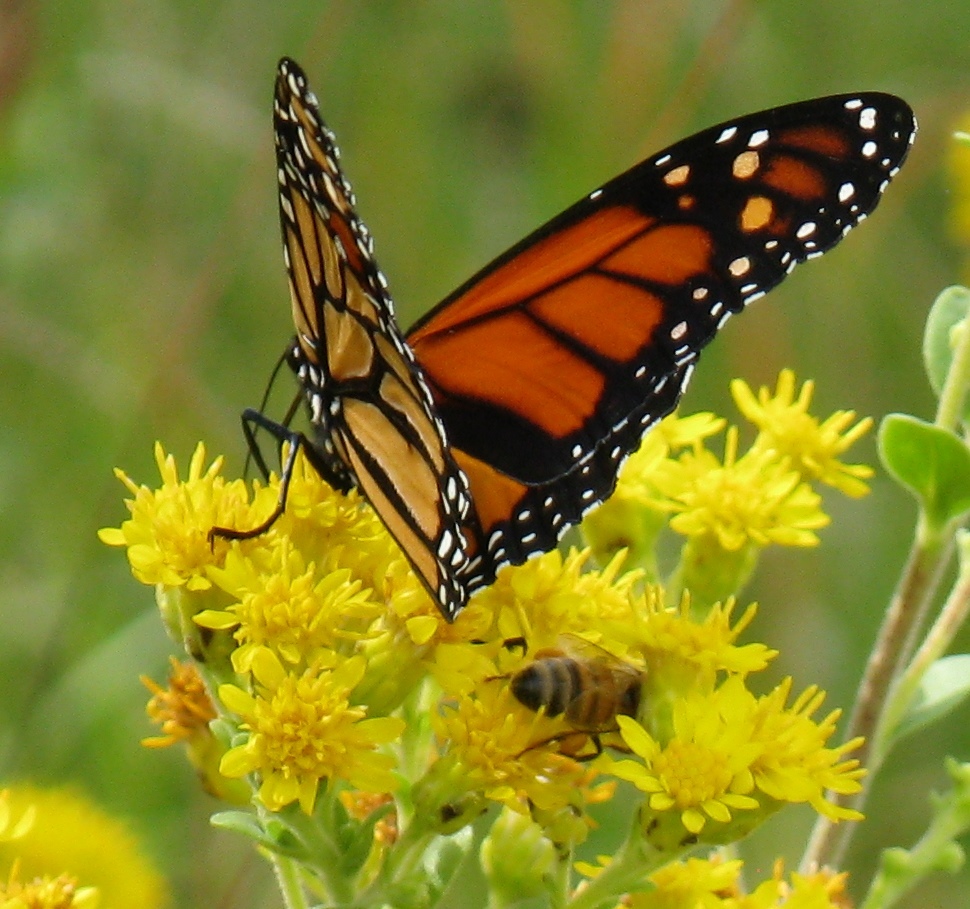 Minnesota state parks and trails play an important role in restoring and managing butterfly habitats on public lands throughout the state. Look for monarchs, the state butterfly, as they fuel up before their trip south at state parks such as Buffalo River, Flandrau, Glendalough, Crow Wing, Sibley and Wild River.
I won't wax poetic about fall colors. Truth be told, the current drought will play a negative effect on this year's "brilliance." Keen observers noted color changes and leaves dropping as soon as early August!
Color me optimistic, but I will be outside looking for other signs of the new season, like migrating birds and monarch butterflies. Val Cervenka, Forest Entomologist and official fall color predictor for the MN DNR, recommends we "Let the lemons make lemonade! Head to the prairie to see beautiful native grasses that resist drought with their deep roots. If you see pockets of beautiful, vibrant color, that's going to be the bonus this year."
Did you know that studies show that spending time in nature reduces stress and even lowers blood pressure? Bright colors or not, you can still reap the mental and physical health benefits from time immersed in nature and fall in love with fall all over again.

As days get shorter in the fall, there's less sunlight for photosynthesis. Chlorophyll makes way for other pigments and, voila, orange and red and purple and yellow dominate the landscape.
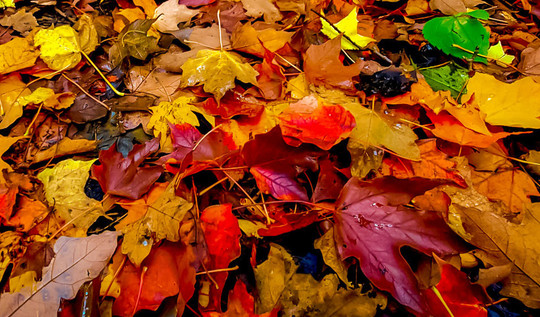 Plants convert carbon dioxide into sugars (glucose and starch) and oxygen by using energy from the sun through photosynthesis. Chlorophyll is the green pigment necessary for photosynthesis. The decrease in photosynthesis that comes with decreased daylight means trees stop producing chlorophyll. As the green pigment fades, other pigments present in the leaf become visible.
Weather
While light has the most impact on seasonal changes to plants, weather has an impact, too. High quality foliage, a product of a warm, humid summer, will produce brilliant colors when exposed to sunny, cool fall days. A light frost can have a positive impact, but hard freezes can ruin the display. Cool, wet summers can cause premature displays of color.
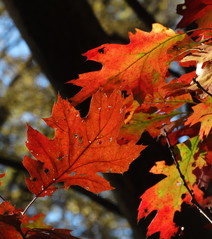
Drought
A mild summer drought may increase the display. A severe drought such as the one we've experienced usually dulls colors and causes premature leaf shedding. The lack of water reaching the canopy results in reduced sugar production, so leaves release more carbon dioxide. The stress means both the chlorophyll and carotenoids break down. Minnesota's landscape likely will be filled with more subtle colors of tan, bronze and auburn.
Leaf Drop
Trees hold on to leaves to continue drawing nutrients, even after chlorophyll production stops. They eventually shed them to save energy and go into a period of dormancy.
|
Most years before leaves drop, nature delights us with amazing (albeit fleeting) fall color, displaying vibrant shades of yellow, orange, purple and red.
The Colors of Antioxidants
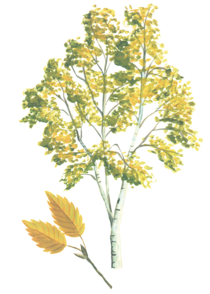
Yellow, Orange – Carotenoids
Carotenoids, the antioxidants ubiquitous in leaves, protect chlorophyll. With chlorophyll no longer in production in fall, we see their yellow and orange pigments on trees such as ash, aspen, basswood, birch, cottonwood and elm.
When the yellow carotenoids break down, their color is replaced by the brown that results from oxidation of tannins in the leaf.
FUN FACT: Carotenoids are found in foods such as pumpkin, carrots and tomatoes, and help reduce the risk for certain cancers and eye disease.
|
Above, illustration of a yellow birch tree with leaves displaying typical fall color. Below, illustration of a red maple tree with leaves in typical fall color. ARTIST: Amy Beyer, DNR

Purple, Red – Anthocyanin
Leaves of certain trees produce an antioxidant called anthocyanin, a result of a reaction of sugars with compounds in the leaf. Anthocyanin pigments are red and purple and intensify in the fall, when days are sunny and nights are cool, causing sugars to get trapped in the leaf. Maple, oak and cherry are some trees that display these pigments.
Anthocyanin extends the time the tree can draw nutrients from leaves by lowering their freezing point, so they can stay on the tree longer. This antioxidant also helps leaves recover quicker when damaged by insects feeding on them.
FUN FACT: Foods high in anthocyanin such as blueberries, blackberries and dark cherries help prevent human illnesses, including neurological and cardiovascular diseases, cancers, diabetes and inflammation.
A lot more on the science of fall:
|


Coniferous Forest
Aspen and tamarack, both displaying yellow leaves in fall, are predominant, along with birch and basswood. The sugar maple varies in color from yellow to orange to deep red.
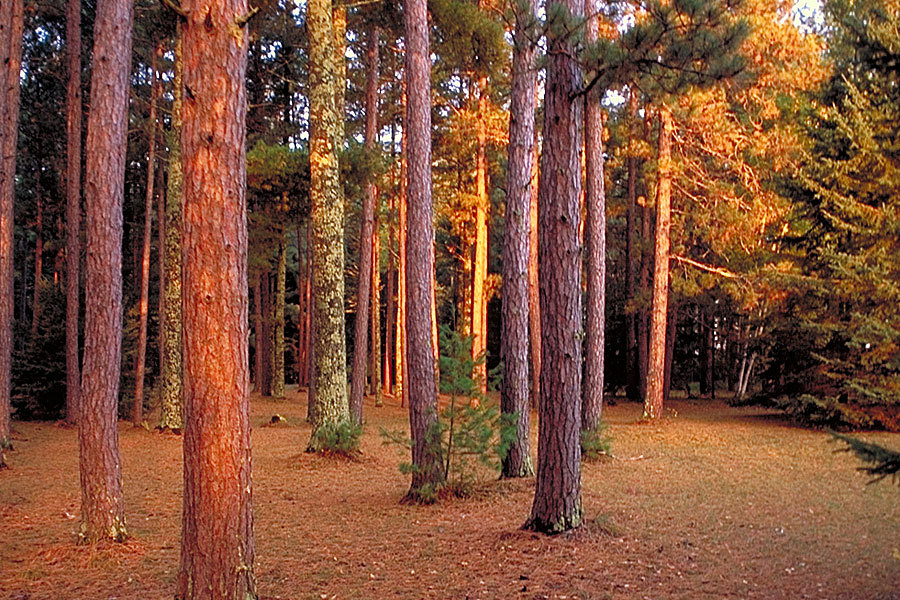 Sit by the shore of the Mississippi River at Schoolcraft State Park to admire the fall colors of deciduous trees as they pop brightly against the dark evergreen hues of the conifers. Bike or ride an ATV following the Taconite State Trail as it winds through forests of birch and aspen intertwined with pine.
Tallgrass Aspen Parkland
Aspen, displaying yellow leaves in the fall, is the most common tree. You can also see scattered bur oaks with their brown leaves.
Warblers and finches are abundant during spring and fall migrations at Old Mill State Park. Follow the Hiking Club trail, Agassiz, a 1.3 mile (2 km) loop through the edge of a prairie scattered with a mix of deciduous and coniferous trees. You will catch glimpses of the Middle River and, maybe, of some of the wildlife that uses the river valley as an access corridor.
Deciduous Forest
Sugar maple, oaks and cherry are common, all of them red to purple in fall.
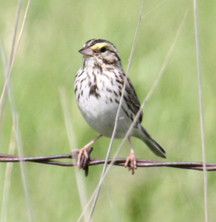
The Minnesota River Valley contains a magnificent combination of habitats including river lowlands, floodplain forests, lakes, marsh and prairie, all along the Minnesota River. The Dakota gave the river its name, Mini Sota, and fished, hunted, and harvested wild rice from floodplain lakes. The hillsides and bluffs support oak forest and oak savanna remnants and offer outstanding scenic overlooks. Thousands of song birds and waterfowl are attracted to the extensive wetlands in the valley as they make their annual migrations through the valley flyway. The fall migration of sparrows (song sparrow pictured) is excellent in the grass and brush habitat. The Minnesota Valley State Recreation Area preserves part of the Minnesota River Valley and the Minnesota Valley State Trail parallels the river. With paved and unpaved sections, the trail offers different outdoor recreation opportunities, including hiking, biking, horseback riding and mountain biking.
|

Prairie Grasslands
Trees are mostly confined to growing along rivers. Look for the yellow leaves of silver maple and cottonwood.
At Kilen Woods State Park oak trees grow on the steep slopes of the Des Moines River valley. Look for scattered bur oak trees, wild plums and hawthorns growing in the prairie, among big bluestem (pictured), Indian grass, blazing star, and purple coneflowers.
Built on a former railroad grade, the 22-mile (35 km) paved stretch of the Glacial Lakes State Trail is generally level and wheelchair accessible — which makes it a great destination for skating, as well. There is a grass treadway and shoulders for horseback riding. This trail cuts across the border of the western tallgrass prairie and eastern deciduous forest biomes. Though much of the area has been cultivated, remnants of virgin prairie, wetlands, and scattered woodlots can be seen along the way.
|


By Guinevere C. Daleiden (Age 9)
 Budding artist and naturalist Guinevere Daleiden shared this very accurate depiction of a red maple leaf and a brown bur oak. We love the macro approach to fall colors!
 The faces and stories of our visitors and staff.
Jennifer was the main contributor for this issue. Who else but a tree "whisperer" to explain the science of fall?
A 5th grade outing introduced Jennifer to a boggy bottom blanketed with sphagnum moss, blooming with carnivorous plants and infinite with black spruce after black spruce. The view created a forest high she’s never climbed down from.

Teegarden – “It really should be TREEgarden,” she admits – has a knack for turning any conversation into tree talk. In her role as outreach specialist for the DNR’s division of Forestry, Teegarden is able to turn her soft spot for trees and forests into a hard desire for touting their benefits. “I encourage woodland owners, homeowners, and communities to actively manage their trees and forests to keep them healthy,” she said.
Healthy forests are resilient forests, and that resilience is a benefit with which Teegarden can particularly relate. Now a two-decade melanoma survivor, her skin cancer scare effectively ended her dream of becoming a field forester. But it could do nothing to squash her primary love of forestry. Before her current job in Forestry, Teegarden taught earth sciences for eight years, sparking the next generation of peatland pupils.
Other than the science of fall, Jennifer's been geeking out on how trees communicate through roots. For example, a tree under attack by a forest pest sends a message to its neighbors letting them know to put up their defenses.
By Anthony Hauck, Forestry Communications Coordinator
|
|